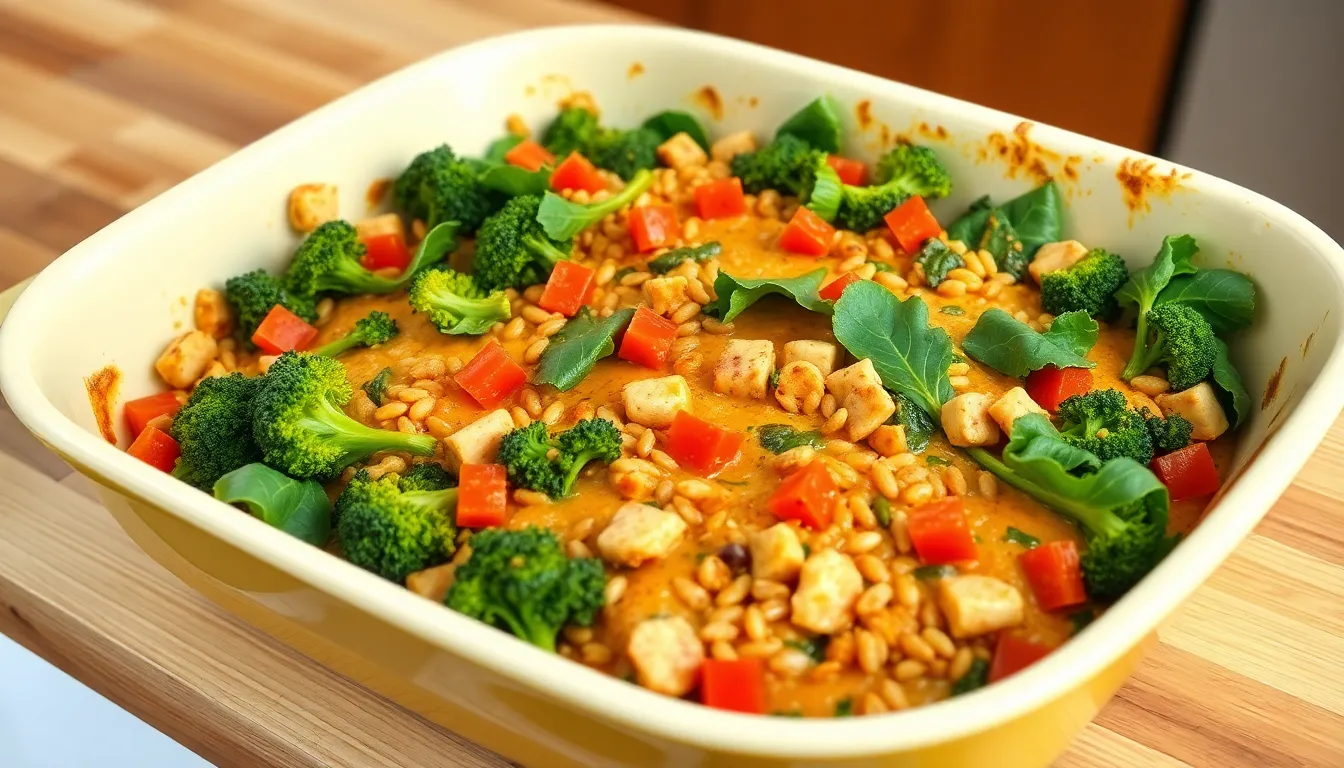Casseroles often get a bad rap as the guilty pleasure of the dinner world. But what if they could be both delicious and nutritious? Enter easy healthy casserole recipes—your new kitchen superheroes ready to save weeknight dinners from the clutches of takeout. They’re like the comfort food that went to the gym and came back with a six-pack!
Imagine a bubbling dish packed with wholesome ingredients, all while being as simple as throwing everything into one pot. These recipes not only satisfy cravings but also keep the health police at bay. With a sprinkle of creativity and a dash of humor, cooking becomes a delightful adventure. So grab that baking dish and prepare to impress your taste buds without sacrificing your health. Who knew being healthy could taste this good?
Table of Contents
ToggleEasy Healthy Casserole Recipes
Casseroles allow for a mix of flavors and nutrients in one dish. Simple ingredients often come together to create hearty meals. Here are several easy healthy casserole recipes that fit different dietary needs.
1. Quinoa and Black Bean Casserole
Quinoa acts as a protein-rich base, while black beans provide fiber. This casserole typically includes tomatoes, bell peppers, and spices for added flavor. Bake it for 25 minutes or until heated through.
2. Chicken and Broccoli Bake
Chicken breast lends lean protein, and broccoli offers vitamins and minerals. Mixing these with brown rice creates a complete meal. Utilize low-fat cheese for a creamy texture.
3. Sweet Potato and Lentil Casserole
Sweet potatoes deliver antioxidants, while lentils contribute protein and iron. Layer slices of sweet potato with cooked lentils and spices for a nutritious dish. Bake at 375°F for about 30 minutes until tender.
4. Vegetable and Brown Rice Casserole
Brown rice forms the foundation for this colorful dish. Seasonal vegetables like zucchini, carrots, and spinach help boost nutrients. Season with herbs and bake for 20 to 30 minutes.
5. Tuna Noodle Casserole
Canned tuna simplifies meal prep while packing in protein. Combine with whole-grain pasta and peas for fiber. Using Greek yogurt instead of cream creates a healthier alternative.
These easy healthy casserole recipes turn ingredients into satisfying and nutritious meals. Enjoy cooking with fresh ingredients makes preparing wholesome dinners enjoyable and accessible.
Benefits of Casserole Meals

Casserole meals offer numerous advantages that make them excellent for healthy eating. These dishes combine various ingredients, enhancing nutrition while keeping meal preparation simple.
Nutritional Advantages
Casseroles can incorporate a range of nutrient-dense ingredients. They often include vegetables, lean proteins, and whole grains, creating balanced meals. Each serving supplies essential vitamins and minerals. For example, adding broccoli or spinach enriches casseroles with fiber and antioxidants. Utilizing quinoa or brown rice increases whole grain intake, promoting digestive health. By integrating legumes, such as black beans or lentils, protein content rises while saturated fats decrease. Overall, casseroles highlight wholesome ingredients, ensuring nutritious options for any diet.
Time-Saving Convenience
Casseroles save time in meal preparation and cooking. Many recipes can be prepared in advance, allowing for quicker weeknight dinners. Assembly usually takes less than 30 minutes, making it easier to cook for busy schedules. Often, casseroles require only one baking dish, minimizing cleanup duties. Most recipes can serve multiple portions, which also helps with meal planning. By making a large batch, individuals can enjoy leftovers throughout the week. This convenience fosters healthier eating habits without sacrificing flavor or variety.
Key Ingredients for Healthy Casseroles
Healthy casseroles feature a variety of ingredients that enhance both flavor and nutrition. The primary components often include fresh vegetables, lean proteins, and whole grains, providing balance and richness in every bite.
Vegetables
Bright, colorful vegetables add essential nutrients and vibrant flavors to casseroles. Options like spinach, carrots, bell peppers, and zucchini contribute fiber, vitamins, and minerals while enhancing visual appeal. Incorporating vegetables is straightforward; simply chop them up and layer them with other ingredients. Leafy greens and cruciferous vegetables introduce cancer-fighting compounds, making casseroles both delicious and beneficial. Seasonal produce can elevate taste and nutrition, allowing for year-round variety in meals.
Proteins
Lean proteins play a pivotal role in creating satisfying casseroles. Choices such as chicken breast, turkey, beans, and tofu provide necessary amino acids while keeping dishes light. Rotisserie chicken offers convenience and flavor without excessive fat. Cooking lentils or quinoa adds plant-based protein, making the meal hearty. These protein sources help to maintain energy levels, support muscle health, and contribute to a feeling of fullness. Combining different proteins can enrich the overall taste and nutrient profile of the dish.
Whole Grains
Whole grains are essential for adding fiber and bulk to casseroles. Brown rice, quinoa, and whole wheat pasta serve as solid base options. Each of these grains supplies sustained energy, promoting overall health. Quinoa, with its complete protein profile, enhances the nutritional value further. Opting for whole grains over refined varieties contributes to better digestion and weight management. Incorporating grains helps achieve a well-rounded meal, blending seamlessly with proteins and vegetables.
Popular Easy Healthy Casserole Recipes
Casseroles offer a variety of flavors and nutrients. Here are some popular easy healthy casserole recipes that cater to different tastes and dietary needs.
Veggie-Packed Quinoa Casserole
Quinoa provides a protein-rich base for this casserole. Fresh vegetables like spinach, bell peppers, and zucchini enhance nutritional value and flavor. Incorporating diced tomatoes adds moisture and a hint of acidity. Seasonings such as garlic powder and oregano deepen the taste profile. This casserole bakes in about 30 minutes, making it perfect for quick weeknight meals. Serving options include fresh herbs or a sprinkle of cheese for added richness.
Chicken and Broccoli Rice Casserole
Tender chicken and bright broccoli create a balanced dish in this casserole. Brown rice serves as a wholesome base, absorbing flavors from each ingredient. Adding low-fat cream of chicken soup simplifies the preparation while maintaining creaminess. Fresh garlic and onion introduce aromatic notes. Baking this casserole for approximately 35 minutes results in a delicious, hearty meal. Topping with whole grain breadcrumbs creates a satisfying crunch.
Sweet Potato and Black Bean Casserole
Sweet potatoes and black beans blend well in this nutritious dish. Rich in fiber, they promote fullness and support digestive health. Combining spices like cumin and chili powder enhances the flavor, creating a comforting warmth. Layering the ingredients creates a pleasing aesthetic while ensuring even cooking. This casserole bakes for around 40 minutes, resulting in a savory treat. Garnishing with cilantro adds a vibrant touch and freshness.
Tips for Making Healthier Casseroles
Making healthier casseroles involves simple adjustments to enhance nutrition without sacrificing flavor. Small changes can lead to significant improvements in overall health.
Ingredient Substitutions
Opt for whole grain pasta instead of traditional pasta to boost fiber content. Substitute sour cream with Greek yogurt for creaminess without added fat. Fresh vegetables like spinach or zucchini replace starchy sides, adding nutrients and volume. Use lean proteins like turkey or beans instead of higher-fat meats to reduce calories. Nutritional yeast provides a cheesy flavor without dairy; it enriches dishes with vitamins. Incorporate low-sodium broth for moisture, cutting down on added salt while maintaining flavor.
Portion Control
Control portion sizes for balanced meals. Serve casseroles in smaller dishes to discourage overserving. Utilize measuring cups when dishing out portions; this promotes awareness of serving sizes. Heaping servings quickly contribute to excessive calorie intake. Include a side salad or steamed vegetables alongside the casserole for added nutrients without greatly increasing calories. Filling half the plate with vegetables keeps meals nutritious and satisfying. Consider using smaller plates; this optical trick helps in managing portion sizes effectively.
Embracing easy healthy casserole recipes opens the door to delicious meals that nourish the body and satisfy the palate. With a variety of flavors and ingredients available, these dishes can cater to any dietary preference while saving time in the kitchen.
By incorporating fresh vegetables lean proteins and whole grains, anyone can create balanced meals that don’t compromise on taste. The versatility of casseroles makes them an ideal choice for busy weeknights or meal prep.
With the right tips and recipes at hand, cooking can become an enjoyable experience that fosters healthier eating habits. So why not explore the world of healthy casseroles and discover how simple it is to whip up satisfying meals that everyone will love?





